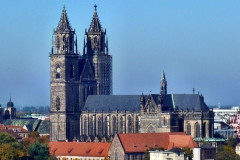Saxony-Anhalt
Description
Saxony-Anhalt is a landlocked federal state of Germany surrounded by the federal states of Lower Saxony, Brandenburg, Saxony and Thuringia.
Its capital is Magdeburg. Saxony-Anhalt covers an area of 20,447.7 square kilometres (7,894.9 sq mi) and has a population of 2.34 million.
Saxony-Anhalt should not be confused with Saxony or Lower Saxony, also German states.
Geography
Saxony-Anhalt is one of 16 Bundesländer (see German: Bundesland) of Germany. It is located in the western part of eastern Germany. By size, it is the 8th largest state in Germany and by population, the 10th largest.
It borders four fellow Bundesländer: Lower Saxony to the north-west, Brandenburg to the north-east, Saxony to the south-east, and Thuringia to the south-west.
In the north, the Saxony-Anhalt landscape is dominated by plain (North German Plain). The old Hanseatic towns Salzwedel, Gardelegen, Stendal, and Tangermünde are located in the sparsely populated Altmark. The Colbitz-Letzlingen Heath and the Drömling near Wolfsburg mark the transition between the Altmark region and the Elbe-Börde-Heath region with its fertile, sparsely wooded Magdeburg Börde. Notable towns in the Magdeburg Börde are Haldensleben, Oschersleben (Bode), Wanzleben, Schönebeck (Elbe), Aschersleben and the capital Magdeburg, from which the Börde derives its name.
The Harz mountains are located in the south-west, comprising the Harz National Park, the Harz Foreland and Mansfeld Land. The highest mountain of the Harz (and of Northern Germany) is Brocken, with an elevation of 1,141 meters (3,735 ft). In this area, one can find the towns of Halberstadt, Wernigerode, Thale, Eisleben and Quedlinburg.
The wine-growing area Saale-Unstrut and the towns of Zeitz, Naumburg (Saale), Weißenfels, and Freyburg (Unstrut) are located on the rivers Saale and Unstrut in the south of the state.
The metropolitan area of Halle (Saale) forms an agglomeration with Leipzig in Saxony. This area is known for its highly developed chemical industry (the Chemiedreieck - chemical triangle), with major production plants at Leuna, Schkopau (Buna-Werke) and Bitterfeld. Finally, in the east, Dessau-Roßlau and Wittenberg are situated on the Elbe (as is the capital Magdeburg) in the Anhalt-Wittenberg region.
History
In April 1945 the US Army took control of most of the western and northern area of the future Saxony-Anhalt. The U.S. Group Control Council, Germany (a precursor of the OMGUS) appointed the first non-Nazi officials in leading positions in the area. So Erhard Hübener, furloughed by the Nazis, was reappointed Landeshauptmann (state governor). By early July the US Army retired in order to allow the Red Army taking Prussian Saxony as part of its Soviet occupation zone, as agreed by the London Protocol in 1944.
On 9 July the Soviet SVAG ordered the merger of the Free State of Anhalt, Halle-Merseburg, the governorate of Magdeburg (in its then borders), Allstedt (before Thuringia) and some Brunswickian eastern exclaves and salients (Calvörde and the eastern part of the former Blankenburg district) into the Prussian Province of Saxony. While the prior Saxon Erfurt governorate had become a part of Thuringia.
For the earlier history see the respective articles of these entities before 1945. Anhalt takes its name from Anhalt Castle near Harzgerode; the origin of the name of the castle remains unknown.
The SVAG appointed Hübener as president of the provincial Saxon administration, a newly created function. The administration was seated in Halle an der Saale, which became the capital, also of later Saxony-Anhalt until 1952. On 3 September 1945 the new administration enacted by Soviet-inspired ordinance the mass expropriations, mostly hitting holders of large real estates, often of noble descent.
On the occasion of the first as well as one and only election in the Soviet zone, allowing parties to really compete for seats in provincial and state parliaments, on 20 October 1946, the Province of Saxony was renamed into Province of Saxony-Anhalt (Provinz Sachsen-Anhalt), accounting for the prior merger. On 3 December 1946 the members of the new provincial parliament elected Hübener the first minister-president of Saxony-Anhalt with the votes of CDU and Liberal Democratic Party of Germany (LDPD). So he became the only governor in the Soviet zone, who was no member of the communist Socialist Unity Party of Germany (SED). He was an inconvenient governor for the Soviet rulers.
After the official Allied decision to dissolve the Free State of Prussia, which had remained in limbo since the Prussian coup of 1932, its former provinces, in as far as they still existed, achieved statehood, thus the province emerged into the State of Saxony-Anhalt on 6 October 1947. It became part of the German Democratic Republic (East Germany) in 1949. From 1952 to 1990 the East German states had been suppressed and Saxony-Anhalt's territory was divided into the East German districts of Halle and Magdeburg. In 1990, in the course of German reunification, the districts were reintegrated as a state.
In 2015 the skeletal remains of an ancient inhabitant of Karsdorf dated from the Early Neolithic (7200 BP) were analyzed, he turned out to belong to the paternal T1a-M70 lineage and maternal lineage H1.
Culture
World Heritage Sites
Saxony-Anhalt has the most World Heritage Sites of all states in Germany.
-
Collegiate Church, Castle, and Old Town of Quedlinburg
-
Luther Memorials in Wittenberg
-
Luther Memorials in Eisleben
-
Bauhaus Dessau
-
Dessau-Wörlitz Garden Realm
Anthem
- Lied für Sachsen-Anhalt ("Song for Saxony-Anhalt")
- Motto: Land of the Early Risers

